Housing
Strategic response to Australia’s housing problems long overdue
In just four years since the advent of COVID-19, Australia’s house prices have climbed by a dizzying 50%. Defying orthodox expectations that property inflation would be quelled by rising interest rates, that upward trend has continued even since the RBA’s monetary tightening phase began in mid-2022, with prices up by 12% in that period alone. Continue reading »
The Towns Outsmarting Airbnb
Late last year, New York City made headlines when it all but banned Airbnbs and other short-term rentals within city limits. Since the pandemic, Airbnb had overtaken an estimated 39,000 rental units, hollowing out neighborhoods and causing already-high rents to grow even higher.
“You would see tourists on the streets in neighborhoods where there weren’t any hotels,” recalls New York-based artist and activist Murray Cox. The sound of rolling suitcases could be heard at all hours. Once tight-knit communities began to feel lifeless. When Cox ran the numbers on his own neighborhood — Bed-Stuy in Brooklyn — he found about 1,000 listings. Cox also heard horror stories from other parts of the city. “People would move into a building and then find that the building was full of tourists day in and day out,” he says. “In some cases, they would be so uncomfortable they’d feel forced to leave.”
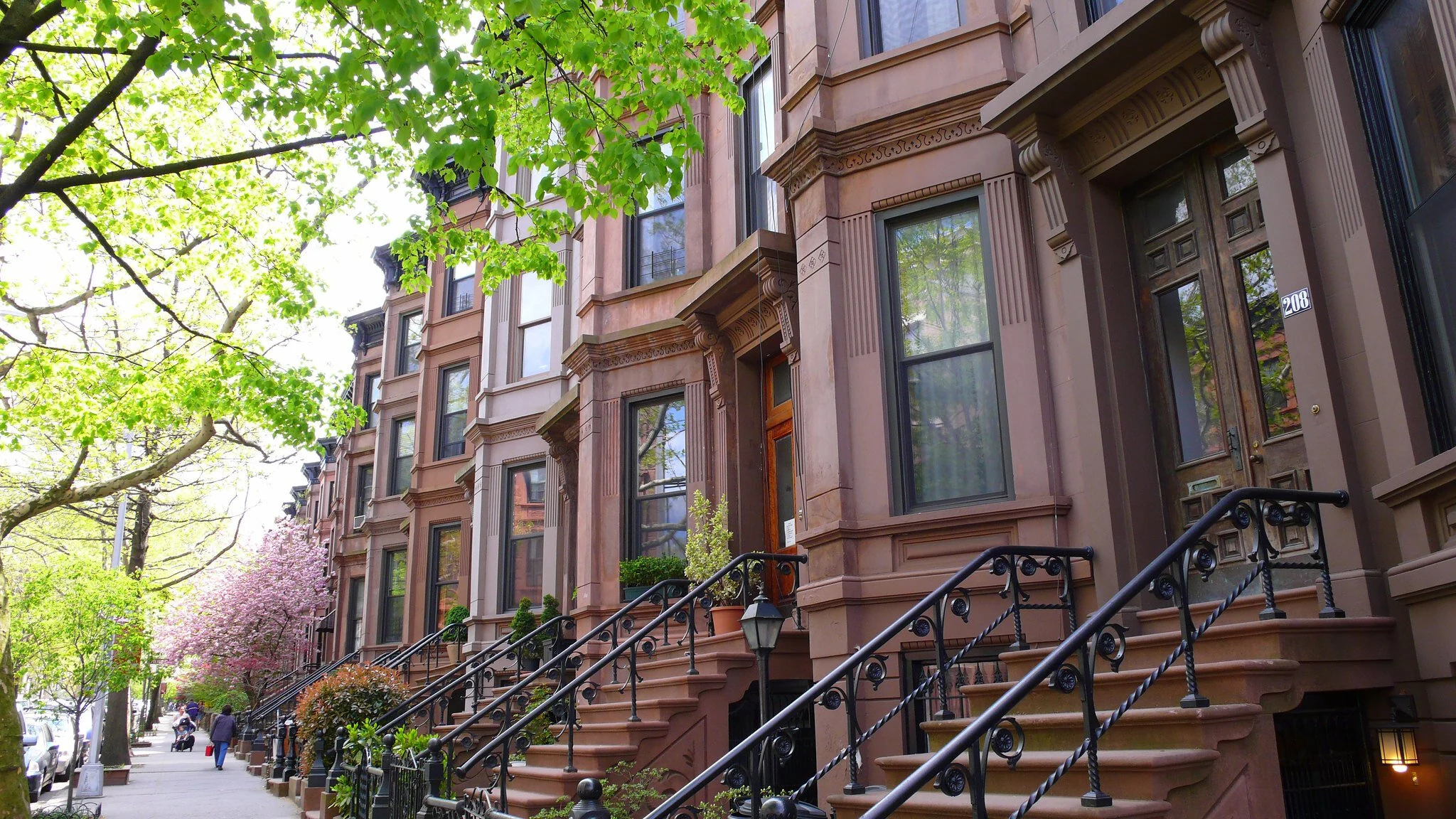 New York City’s crackdown on Airbnbs is part of a growing trend. Credit: Matthew Rutledge / Flickr
New York City’s crackdown on Airbnbs is part of a growing trend. Credit: Matthew Rutledge / Flickr
So, in September of 2023, New York City decided to do something about it. A series of bold requirements capped the total number of short-term rentals (STRs) and limited guests to just two at a time. They required STR operators to be primary homeowners — and to be present in the home while hosting. The city also promised to enforce those requirements, a move that would wipe out nearly 90 percent of active listings at the time.
Though it may sound revolutionary, New York’s crackdown isn’t the first of its kind. In fact, it’s part of a growing trend — one largely spearheaded by much smaller towns. Over the last decade, communities from Irvine, California, to Durango, Colorado, have implemented clever regulations, taxes and zoning policies to hobble the STR market — or, in some cases, eliminate it altogether. As the success stories pile up, a growing body of research points to the dramatic positive impacts of policies like these, including lower rents, more equitable housing markets and the promise of a sustainable tourism economy.
When Airbnb was founded more than a decade ago, it was heralded as the harbinger of a new sharing economy. In theory, home-sharing platforms — including Airbnb, Couchsurfing, VRBO, FlipKey and Homestay — would put underutilized bedrooms to use, matching budget-conscious travelers with locals in need of a little extra cash. The system would funnel tourism dollars into small towns in a more equitable way. It seemed like a win-win. But within a few years, one clear loser emerged: communities.
“It didn’t take very long for people to realize the sharing economy was basically a scam,” explains Cox, who later went on to found data-sharing platform Inside Airbnb. “People weren’t using that car that was sitting in the driveway to drive Uber. And people weren’t just renting out a sofa or a spare bedroom.” Instead, people saw an economic opportunity they could invest in. And they started buying whole homes to rent out on Airbnb.
In many cases, speculators and investment companies were buying multiple homes expressly for short-term rental use. According to Cox, about two-thirds of Airbnb rentals in the US are in a property portfolio, which means the host owns and rents more than one property. And the top one percent of operators have more than 300,000 Airbnb listings among them — a stat that points to huge conglomerates gobbling up the market.
 In September of 2023, New York City enacted bold requirements that capped the total number of short-term rentals and limited guests to just two at a time. Credit: RightFramePhotoVideo / Shutterstock
In September of 2023, New York City enacted bold requirements that capped the total number of short-term rentals and limited guests to just two at a time. Credit: RightFramePhotoVideo / Shutterstock
These days, Airbnb isn’t just a way to share underutilized bedrooms; it’s big business.
Right now, about 90 percent of Airbnbs in Bozeman, Montana, and Nashville, Tennessee — both popular vacation spots — are whole homes. Both Bozeman and Nashville are also relatively small towns with exploding local populations and limited housing stock. That means that every home set aside for a year-round STR listing is a home unavailable to local residents struggling to find — and afford — housing. In extreme cases, the STR explosion has forced longtime locals to move away. The so-called “Airbnb Effect” can hollow out once-vibrant communities.
This effect is most visible in popular vacation hot spots. In Hawaii, for example, out-of-towners have bought up so many homes that few are left for Native Hawaiians.
Crushed by negative news?
Sign up for the Reasons to be Cheerful newsletter.
[contact-form-7]
“On Maui alone, 52 percent of homes are sold to nonresidents, and 60 percent of condos and apartments have gone to investors and second homeowners,” writes Stanford researcher Noah Jordan Magbual in a recent report. “The once indigenous population of the Hawaiian archipelago are now outcasts in their own home.”
The Airbnb Effect also impacts bigger urban areas. In 2015, one study found that STRs had sucked at least 10 percent of New York’s available housing off the market. Another New York study showed that this reduction in supply led to rent increases of up to hundreds of dollars per year. In Barcelona, the effect is even more severe, with rents rising by seven percent and housing costs rising by up to 17 percent in popular neighborhoods.
For some cities, the proliferation of STRs has become more than just an economic issue; it’s existential. That’s especially true in New Orleans, the longtime home of Jeffrey Goodman, an urban planner and consultant who specializes in STRs.
Credit: Mr. Nixter
Tourists are drawn to New Orleans for culture: art, food, music and more. But the city is becoming less and less affordable for the people who make those things possible.
“We were one of the earlier cities to experience the growth in short-term rentals,” Goodman says. “And we’re in a unique place because so much of what we sell is culture. It’s art. It’s food. But the people who make the art and cook the food and play the trumpets have a hard time living here.” So, if the locals who make New Orleans special are forced to move away, what’s left?
“There are a lot of cities asking themselves this question,” says Goodman. “Are we a city anymore or are we just Disneyland?”
According to Goodman, the Airbnb Effect is stronger in small communities, like mountain towns or beach towns, which tend to have limited housing stock, high home prices and little flexibility to adapt to fluctuations in housing availability. That may be why small towns were among the first to fight back.
In 2014, Durango — a town of 20,000 in southwestern Colorado — passed a series of regulations to combat what one local newspaper called “The Airbnb Apocalypse.” The town, an adventure epicenter for mountain bikers, climbers, skiers and other outdoor sports enthusiasts, isn’t just a tourist magnet. It’s also home to Fort Lewis College, a premiere university for Native American students and Colorado locals. That was an experience Durango was anxious to protect.
Durango’s 2014 regulations banned STRs outright in student neighborhoods. They also limited STRs to two percent of the housing stock elsewhere.
 Tourists ride the Durango & Silverton Narrow Gauge Railroad along the Animas River. Credit: Woody Hibbard / Flickr
Tourists ride the Durango & Silverton Narrow Gauge Railroad along the Animas River. Credit: Woody Hibbard / Flickr
“In doing this, the city made it clear that preserving student housing took precedence over any money they were going to get from tourism,” says Goodman.
Today, city planning officials say the program has been a huge success.
“Durango led the way in creating effective guardrails to protect the community from being overrun with STRs,” says Scott Shine, director of Durango’s Community Development Department. Today, he says, STRs make up just 1.4 percent of the city’s total housing stock. They just aren’t really an issue anymore.
A year later, Santa Monica — an affluent California beach town of 90,000 — passed its own ordinances, banning STRs offering stays of less than 30 days for an entire home. The city also extended its 14-percent hotel tax to STR operators and made it illegal to operate them without a valid business license. According to one estimate, the ordinance has since dropped the city’s number of Airbnb listings by 61 percent, potentially returning more than 1,000 homes to the long-term rental or purchasing markets.
Many of these novel STR policies look great on paper, but the truth is that they’re hard to enforce. Few cities have spent more time thinking about this issue than San Francisco.
San Francisco-based housing activist Dale Carlson first heard about the Airbnb Effect back in 2014, when the city was undergoing a major housing affordability crisis. When he learned that nearly five percent of the city’s limited housing stock was devoted to Airbnbs, he decided to get involved.
Carlson helped bring together a coalition of tenants, hotels and property rights groups. By 2015, they’d successfully lobbied for a city ordinance that required hosts to register their STRs, have a business license and pay hotel taxes. But it wasn’t enough.
Credit: Dale Cruse / Flickr
Cities across American watched as San Francisco enacted its platform-accountability policies. Now, some of those cities have enacted policies of their own.
“We still ended up with 15,000 or 16,000 listings,” Carlson says. So, his group asked voters to get behind an entirely new concept: the principle of platform accountability.
“The idea is that [the rental platform] can list and or rent anything it wants, but it can only collect a booking fee on the stuff that’s legal,” Carlson explains. If passed, the ballot measure would put the onus on Airbnb — not the city — to police unregistered and therefore illegal listings. Airbnb fought the initiative, and it fought hard.
“We were defeated in the ballot. Airbnb spent close to $10 million—they outspent us 20 to 1,” Carlson says. But despite the heavy spending, Airbnb barely eked out the win. “So many people had told us, ‘You’re never going to beat them because they’re too big and powerful,’” Carlson says. “But suddenly they didn’t look so powerful. And we didn’t seem so vulnerable.”


Become a sustaining member today!
Join the Reasons to be Cheerful community by supporting our nonprofit publication and giving what you can.
Carlson’s coalition reworked the initiative and tried again. The next time, the ballot measure passed. Within a few months, Carlson says, Airbnb listings in the city had dropped by about 90 percent. Cities across America were watching. Others, like Boston and New York, ultimately adopted platform-accountability policies of their own.
Another important aspect of San Francisco’s policy is that hosts can only use their primary residences as STRs. According to Carlson, that’s dramatically limited speculative purchasing.
“All the folks who were buying up units or renting units and then subletting them on Airbnb — that’s all gone,” he says.
A few years later, Irvine, California, enacted an even more severe policy — with more dramatic results. In 2018, the city banned all short-term rentals under 30 days and hired a fintech firm to track down and report scofflaw hosts. This ban more than halved the number of Airbnb properties. Eight years on, rents in the city have dropped by up to three percent, according to a recent study. That saves tenants about $114 per month on average.
 The city of Irvine banned all short-term rentals under 30 days, cutting the number of Airbnb properties down by more than half. Credit: Matt Gush / Shutterstock
The city of Irvine banned all short-term rentals under 30 days, cutting the number of Airbnb properties down by more than half. Credit: Matt Gush / Shutterstock
Choosing the right STR regulations can be very location-dependent, says Goodman, the city planning consultant. Some towns might need a combination of ordinances, while complete bans might work better in others. But according to Michael Seiler, the College of William and Mary researcher who led the Irvine study, we now have strong evidence that limiting STRs can indeed reduce rents. And, he says, it’s likely that Irvine’s solution could be successfully applied in other towns.
“If I was another policy maker in a sister city, I would say let’s at least try it,” he says. “Because we’ve shown that it does work here.”
New York hasn’t been the only city to act in recent years. In 2023, Bozeman passed regulations forcing STR platforms to ask for operators’ permit numbers. The policy makes it difficult for bad actors to list their homes illegally, and makes it easy for the city to double-check that listings are appropriately registered and legally operating. Bozeman also mandated that STRs be primary residences — not second homes purchased as rental properties.
There may also be some market solutions around the corner. A cadre of startups are taking up Airbnb’s original mission and reworking it into a more holistic, community-friendly approach. New platforms like Trusted Housesitters and ReFlat are making it easier to find mutually beneficial housing swaps, while millennials are bringing time-shares back into vogue in Colorado ski towns.
In the future, these regulatory and entrepreneurial solutions could work together to give travelers affordable lodging options — without sacrificing the needs of local communities.
“A lot of people will say Airbnb is here to stay, but New York City shows you that’s not necessarily the case. When they decided to enforce their housing laws, it was really effective,” says Cox. “New York City’s approach is a good model to show that we can be as restrictive as we want. It’s up to us.”
The post The Towns Outsmarting Airbnb appeared first on Reasons to be Cheerful.
What Happens to U.S. Activity and Inflation if China’s Property Sector Leads to a Crisis?
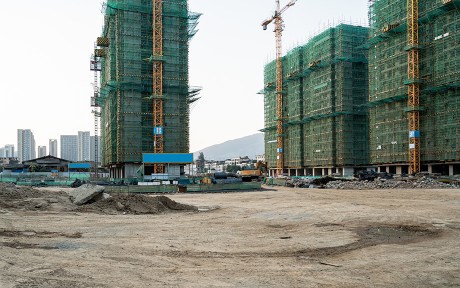
A previous post explored the potential implications for U.S. growth and inflation of a manufacturing-led boom in China. This post considers spillovers to the U.S. from a downside scenario, one in which China’s ongoing property sector slump takes another leg down and precipitates an economic hard landing and financial crisis.
China’s Policy Space Is Becoming More Constrained
In this scenario, Chinese authorities’ policy space proves insufficient to forestall a deep and protracted downturn. Our view is that this scenario is less likely to materialize than the upside scenario described in our previous post. We share the consensus view that the Chinese authorities retain considerable scope for managing the economy and associated financial risks.
In earlier work, we examined the Chinese authorities’ policy space and its potential limits. To recap, China’s policy tools draw added power from unique features of the country’s political and financial system. China’s government maintains direct and indirect control of the country’s financial and nonfinancial sectors. Moreover, the domestic economy is shielded from external shocks by the country’s current account surplus, large stock of foreign exchange reserves, and system of capital controls. Overall, the authorities possess considerable scope for using monetary, credit, and central government fiscal policies to dampen economic fluctuations.
However, policy space is growing more constrained as debt continues to build. The ratio of nonfinancial sector debt to GDP surged again in 2023 and now tops 300 percent (chart below). International experience suggests that rapid debt accumulation is often a harbinger of financial crises or extended periods of sluggish economic growth. This conclusion is also backed by academic research, and explored elsewhere on Liberty Street Economics.
China’s Debt Levels Continue to Climb
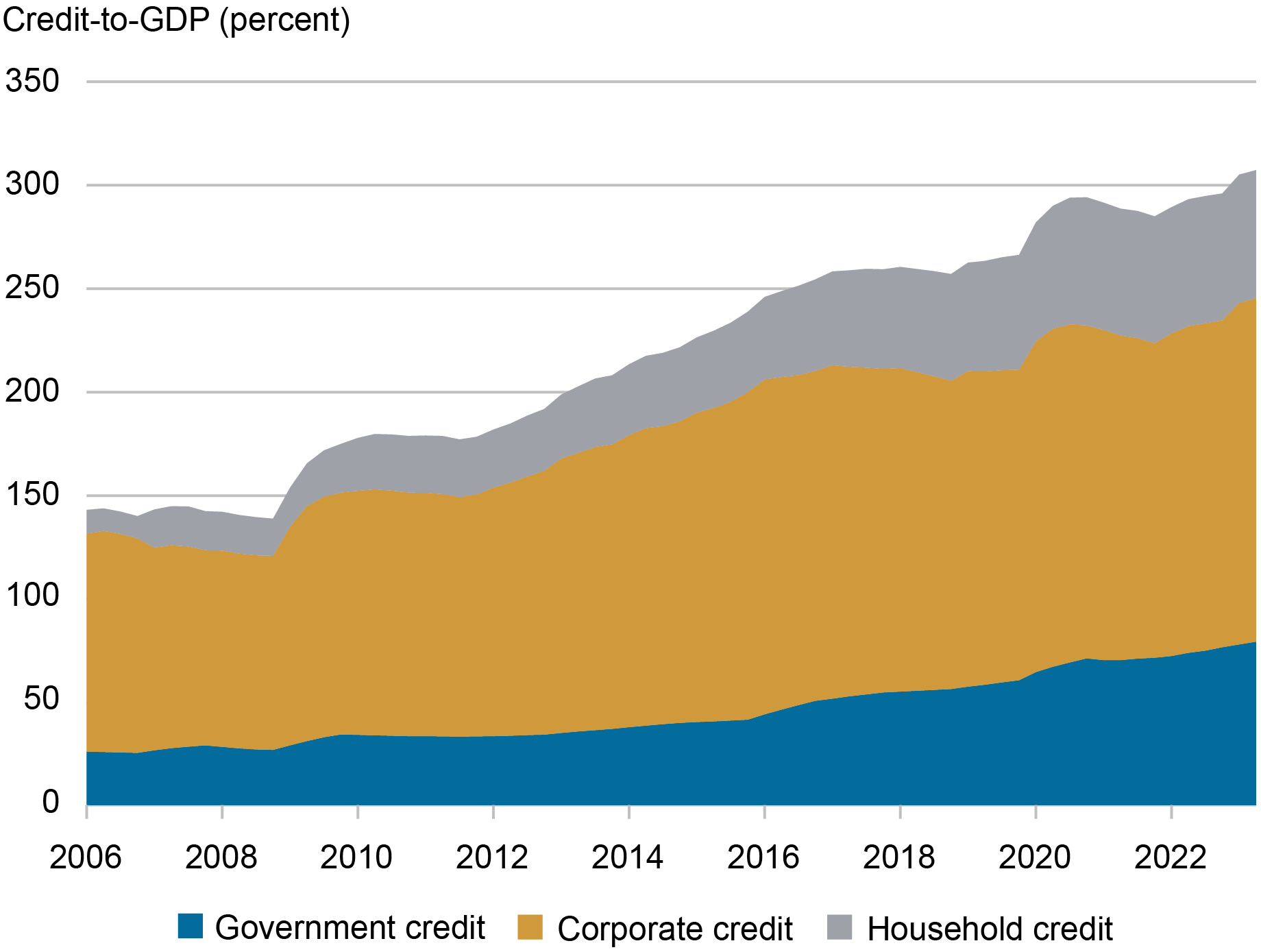 Sources: CEIC; Bank for International Settlements.
Sources: CEIC; Bank for International Settlements.
The Potential for Another Leg Down in the Property Sector
The key driver for our downside scenario would be further stress in the property sector. Since late 2020, new property starts and sales have fallen by two-thirds and one-third, respectively (chart below). Lending to developers came to a nearly complete halt through the end of 2022 before modest net lending resumed when government policy on property sector lending was eased. But total active construction projects have fallen a much smaller 13 percent since peaking in 2021, with stronger state-owned or supported developers continuing work on uncompleted projects. Construction activity could fall further if stronger developers begin to face increased financial pressure.
Further stress in the property sector would amplify ongoing fiscal tightening at the local level. In this case, unique features of China’s political and economic system would work against it. Local governments have traditionally derived a large portion of their revenues from land sales, a source that dries up in a falling price environment. In turn, these fiscal pressures would undermine local governments’ ability to support developers and other local firms, including local manufacturing champions.
Could Property Sector Activity Fall Further?
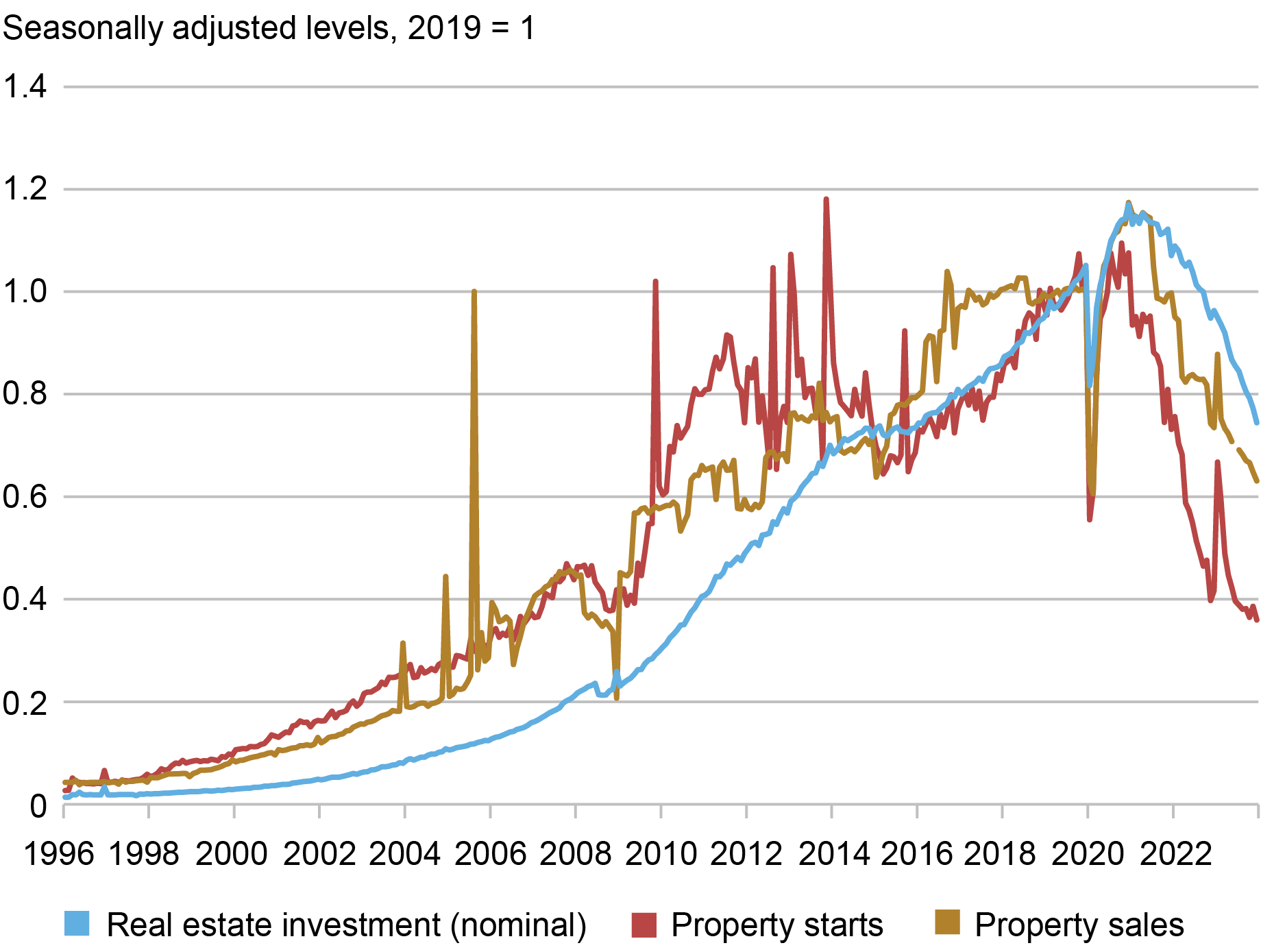 Sources: CEIC; Authors’ calculations.
Sources: CEIC; Authors’ calculations.
Note: Figures are calculated from official published levels.
The key role of the property sector in the Chinese economy makes troubles there a plausible trigger for an economic hard landing and financial crisis. Property-related activity accounted for roughly one-quarter of Chinese GDP before the recent slump and still represents an outsized share of activity by international standards. Property-related credit continues to account for roughly one-quarter of total debt outstanding. And property accounts for roughly two-thirds of household assets. Given this backdrop, it’s no surprise that the property slump has coincided with a severe erosion in household and business confidence.
A Downside Scenario for China and Its Implications for the U.S.
Under our property crash scenario, GDP growth in China falls to zero in 2024. This is followed by a tepid recovery to about 2 percent over the next year. This level represents dramatic underperformance relative to the International Monetary fund (IMF) baseline, which calls for growth of 4.6 percent in 2024 and 4.0 percent the following year. Credit growth (total social financing) also falls below the IMF baseline, albeit less dramatically.
To quantify the impact of this downside scenario on the U.S. economy, we rely on the Bayesian VAR model introduced in our previous post. This model is designed to capture the historical joint dynamics of the U.S. and Chinese economies. We use the estimated model relationships to construct counterfactual paths for U.S. macroeconomic aggregates while constraining Chinese output and credit growth to follow the paths in our crash scenario. As in our previous exercise, we measure scenario impacts against a baseline in which the Chinese economy evolves according to the IMF projections.
The top two panels in the chart below show the behavior of GDP and credit growth—our key conditioning variables—under the crash and baseline scenarios, reported as year-over-year percent changes. As already noted, the crash scenario involves dramatic GDP-growth underperformance relative to the baseline. The remaining panels show the implications of the crash scenario for U.S. and selected Chinese and global macro variables, measured as percentage deviations from the baseline, with the blue shading showing estimated confidence intervals.
This exercise shows that a Chinese hard landing could result in materially weaker U.S. growth and trade performance and lower U.S. inflation, with the largest impacts occurring over the first four quarters following a crash. Real GDP growth falls as much as 2 percentage points (ppt) below baseline before beginning to recover, while export volumes fall as much as 10 ppt below baseline. The PCE price index, for its part, falls some 3 ppt below baseline before crisis impacts begin to fade.
Projected Path for Key Macro Variables in a Hard Landing Scenario
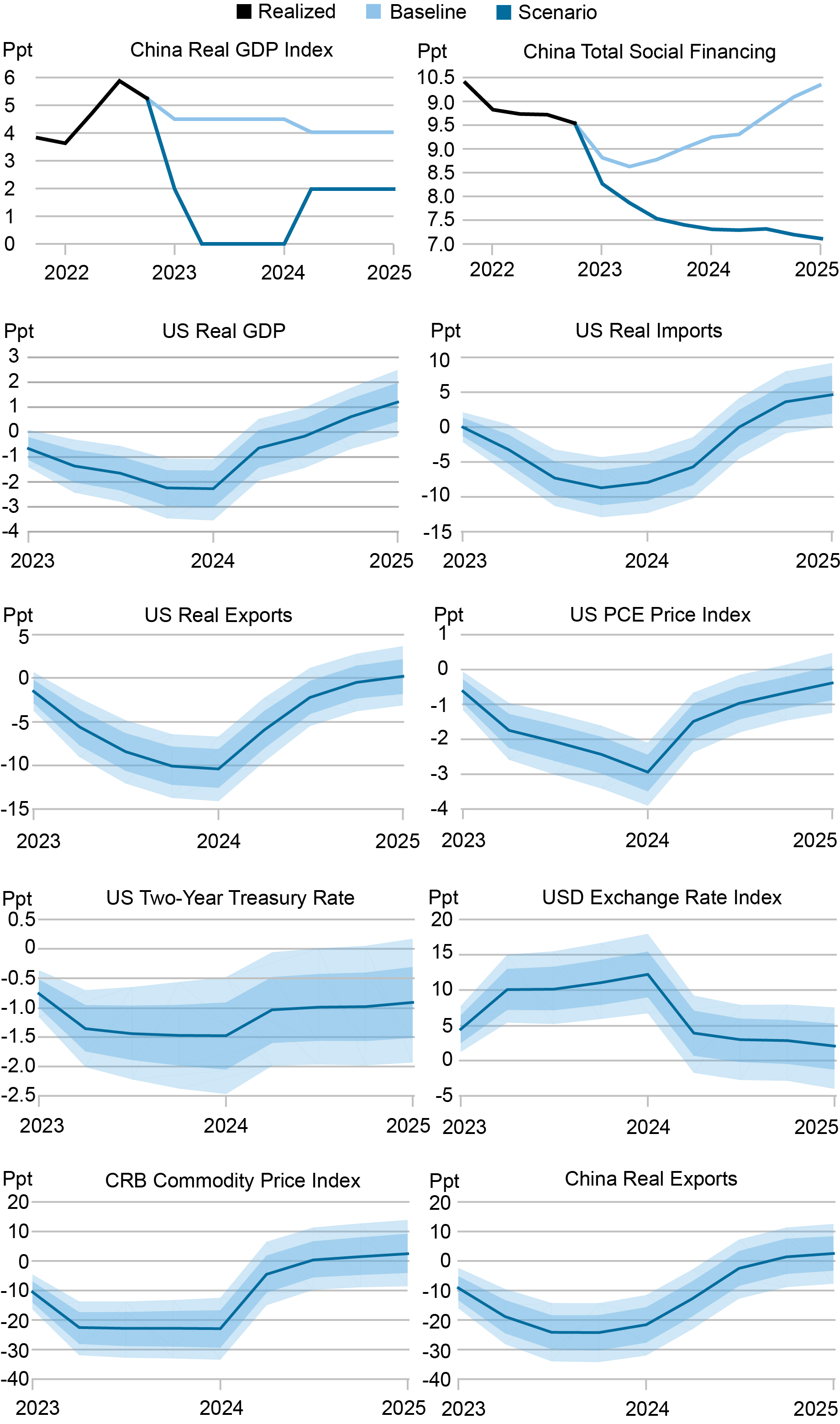 Source: Authors’ calculations based on data from the Federal Reserve Bank of St. Louis FRED database and CEIC.
Source: Authors’ calculations based on data from the Federal Reserve Bank of St. Louis FRED database and CEIC.
The magnitude of these impacts is larger than in our earlier post premised on a manufacturing-led boom in China, consistent with the larger deviation of GDP growth from baseline. The underlying mechanisms are however the same, albeit now working in the opposite direction.
The sudden plunge in Chinese domestic demand growth leads to sharp falls in global commodity prices and Chinese exports. These impacts reflect the key role China plays in global trade and production networks. Weaker Chinese demand translates into weaker demand for China’s worldwide value chain partners, with this impact amplified by the knock-on tightening of those firms’ financing constraints. The deterioration in global trade, of course, feeds into the similar deterioration in U.S. trade volumes.
The U.S. dollar, meanwhile, sees significant appreciation, in line with its longstanding negative correlation with global commodity prices. In the context of our property crash scenario, this strength can be understood as reflecting risk-off behavior among global investors, who seek refuge in U.S. financial markets and U.S. dollar assets. The stronger dollar, in turn, contributes to a tightening in global financial conditions. In fact, the main impact of weaker Chinese demand on global financial conditions is via this indirect channel.
In short, the materialization the property crash scenario in China would tilt the balance of risks for U.S. growth and inflation to the downside. As we’ve discussed, however, the Chinese authorities appear to have adequate tools to contain new downward pressures on the country’s economy. At present, we regard the materialization of this scenario as less likely than the upside manufacturing boom scenario.
The two scenarios, of course, would carry different policy implications. A deep Chinese slowdown would contribute to lower U.S. and global inflation, likely bringing forward investor expectations for policy easing. In contrast, materially faster growth in China might add to the challenges of bringing inflation back to central bank targets, likely pushing out investor expectations for easing.

Ozge Akinci is head of International Studies in the Federal Reserve Bank of New York’s Research and Statistics Group.

Hunter L. Clark is an international policy advisor in International Studies in the Federal Reserve Bank of New York’s Research and Statistics Group.

Jeffrey B. Dawson is an international policy advisor in International Studies in the Federal Reserve Bank of New York’s Research and Statistics Group.

Matthew Higgins is an economic research advisor in International Studies in the Federal Reserve Bank of New York’s Research and Statistics Group.

Silvia Miranda-Agrippino is a research economist in International Studies in the Federal Reserve Bank of New York’s Research and Statistics Group.

Ethan Nourbash is a research analyst in the Federal Reserve Bank of New York’s Research and Statistics Group.

Ramya Nallamotu is a senior research analyst in the Federal Reserve Bank of New York’s Research and Statistics Group.
How to cite this post:
Ozge Akinci, Hunter Clark, Jeff Dawson, Matthew Higgins, Silvia Miranda-Agrippino, Ethan Nourbash, and Ramya Nallamotu, “What Happens to U.S. Activity and Inflation if China’s Property Sector Leads to a Crisis?,” Federal Reserve Bank of New York Liberty Street Economics, March 26, 2024, https://libertystreeteconomics.newyorkfed.org/2024/03/what-happens-to-u-....

Is China Running Out of Policy Space to Navigate Future Economic Challenges?

Financial Crises and the Desirability of Macroprudential Policy

Why Are China’s Households in the Doldrums?
Disclaimer
The views expressed in this post are those of the author(s) and do not necessarily reflect the position of the Federal Reserve Bank of New York or the Federal Reserve System. Any errors or omissions are the responsibility of the author(s).
‘They Can’t Complain or They will Be on the Street’: Delay in Renters Reform Bill Puts Tenants in Peril of Mould, Damp and Dangerous Disrepair
The scale of mould, damp and other illegal conditions in the private rented sector is being heavily underestimated by councils and government and chances to enforce better standards are being missed, a new report on licensing has found.
The research, by charity Safer Renting and The University of York, investigated five local authorities in London that had instituted selective licensing schemes – similar to a driver’s licence for landlords that applies to a certain number of landlords or types of homes in the borough.
They found that, because their housing inspection regime was proactive (i.e. done beforehand in order for the landlord to get a licence) rather than reactive (i.e. done only when concerns are raised by tenants themselves), they identified much higher rates of disrepair than they would otherwise.
One housing officer told the researchers that logged council complaints about standards “nine times out of ten” came from homes in the borough that were inspected under the selective licensing scheme.
Safer Renting highlighted one case of a home they recently inspected – with 13 adults being forced to share a three-bedroom rented house – with one bathroom between them, no fire safety and a collapsed ceiling. Their landlord was making an estimated £62,400 a year in rent from the property.
Housing campaigners have long raised concerns that the ability for landlords to evict tenants without cause – known as a ‘no fault’ eviction – means tenants are scared to complain about illegal, unaddressed disrepair in their homes as they could be evicted by their landlord as a result.
While the government has pledged to abolish the practice since the last election, its promised ‘Renters Reform Bill’ has been repeatedly delayed.
It was finally announced last year, but in October plans for a ban on ‘no fault’ evictions were delayed indefinitely until they were able to complete unspecified reforms to the justice system.
While Levelling Up, Housing and Communities Secretary Michael Gove vowed the ban would come into force by the next election, in recent weeks a group of Tory MPs, many of whom are landlords themselves, have been heavily lobbying the government to water down the Renters Reform Bill.
The situation has reignited concerns that a proposed landlord portal in the Bill, which would see all private landlords forced to add their names to a government licensing register, may not come with the necessary enforcement and standards to ensure those registered on it are actually providing safe homes.
In fact, last month the Charted Institute of Environmental Health (a membership group for housing safety specialists) raised concerns that the proposed ‘Property Portal’ – even if it comes without proper inspections or enforcement – could lead to the government watering down or outlawing separate enforced selective listening schemes.
Report author and Safer Renting head of service Roz Spencer told Byline Times: “This study tells us strongly that selective licensing needs strengthening with enhanced programmes of inspection and enforcement.
“This report adds to the government’s own data showing that even where licensing is in place, landlord non-compliance is the norm.
She added: “Yesterday we inspected an overcrowded, unlicensed house in multiple occupation which illustrates one of the most serious shortcomings in the Government's Renters Reform plans - that renters in houses like this, where they have no room of their own and pitifully poor amenities and conditions, have no security of tenure now and won't have under new 'security of tenure' proposals.
“They can't complain or they will be on the street; only councils with robust licensing and enforcement programmes are going to be able to find and penalise the property owner.
“Yet the Government seem to be indulging backbench attempts to hijack their proposed reforms to argue for abolishing selective licensing. This is a real moment of peril for the renters most in need of protection, as an amended Bill could be worse than doing nothing."
Concerns about rampant disrepair in UK homes have been growing since the mould-related death in 2020 of toddler Awaab Ishak. In January, the Royal College of Physicians warned of a growing number of deaths caused by damp and mould if the problem goes unaddressed by the government.
Previous reporting from The Observer found that local councils are inspecting just half of all reports of damp and mould they receive about the private rented sector.
It also found that in the vast majority (87%) of cases where illegal and dangerous levels of damp and mould were identified, councils opted to follow an informal resolution.
A spokesperson for the Department for Levelling Up Housing and Communities would not confirm if the government would commit to a full licensing scheme as part of the Renters Reform Bill.
They told Byline Times the “landmark” Bill would “deliver a fairer private rented sector for both responsible tenants and good faith landlords” and that a new Decent Homes standard for private rented homes would "ensure landlords are held to account for their performance”.
The housing rental market
Housing is one of life’s essentials but ‘our’ government in treating it like another market, seems to have somehow conveniently forgotten how essential the basic security of a roof over your head is… The dysfunctional purchasing of housing to live in which has everything to do with bank credit and little to do with providing... Read more
How our tax system is making the rich richer. And the poor poorer
Australians frozen out of the housing market cannot expect that government is going to do anything that effectively closes the gap between current house prices and what most of the unhoused could afford as a deposit. Modern politicians of all stripes are all agreed that their political survival depends on doing the maximum to sustain Continue reading »
What If Finding Affordable Housing Worked More Like Matchmaking?
Dozens of framed photographs and paintings on the walls in Gabrielle’s cozy one-bedroom apartment in Boyle Heights showcase her artistry and cherished memories from trips to New Zealand and Europe. Her favorite is a black and white portrait of a miner in New Zealand panning for gold.
Gabrielle (who is comfortable printing only her first name) feels she struck gold, too, when she moved into this light-filled apartment in September 2019. She calls the place — with an open kitchen, a large bathroom and a sweeping view over park greenery and palm trees to the snow-capped mountains outside of Los Angeles — her “safe haven,” after feeling unsafe for several years.
A professional gemologist whose family once had five jewelry stores in Hawaii, she had struggled with alcoholism and mental health issues, and a suicide attempt left her in a coma for five days. While she was recovering from major neck surgery and fighting to be granted disability, she was living in her car in Los Angeles for several months and in transitional housing for more than 15 months. She wondered if she would ever have an apartment again or “be stuck in a hell hole forever.”
 A 2020 report found that Los Angeles had more than one vacant residential unit for every unhoused person. Credit: Ocean Image Photography / Shutterstock
A 2020 report found that Los Angeles had more than one vacant residential unit for every unhoused person. Credit: Ocean Image Photography / Shutterstock
Gabrielle’s luck began to change when a California nonprofit called Brilliant Corners got involved. She had qualified for help from the Los Angeles County Department of Health Services Housing for Health division that gives priority to vulnerable clients with health issues. (Gabrielle contributes 30 percent of her income to the rent, and the rest is covered by the program’s subsidy.) But when the Boyle Heights apartment in a former hospital opened up, the landlord didn’t want to rent to her because of her bad credit. The real estate specialists at Brilliant Corners worked with Gabrielle’s case manager at the local nonprofit Life Steps to convince the landlord he was not taking a big risk in accepting Gabrielle as a renter.
Brilliant Corners was founded in 2004 by several nonprofit service providers with the mission to find housing for people with intellectual and developmental disabilities in three California counties. In 2014, it significantly expanded its mission to extremely low-income Californians and began operating the Flexible Housing Subsidy Pool, in partnership with the Los Angeles County Department of Health Services and private partners such as the Conrad N. Hilton Foundation, as part of the Housing for Health initiative. The Flex Pool is a supportive housing rent subsidy program that helps match vulnerable individuals with available housing options.
Crushed by negative news?
Sign up for the Reasons to be Cheerful newsletter.
[contact-form-7]
The key is its flexibility: “For one landlord, it was a dealbreaker that the applicant had $3,000 in debt. So we paid off half the debt,” says Kolby Vaughn, Brilliant Corners’ associate housing services director in San Diego, which has a Flex Pool that is funded by the Regional Task Force on Homelessness. “For another client, cooking was really important so we spoke with the landlord [to see] if we could put a hot plate in his unit. These are the kind of hurdles we can overcome outside of the bureaucratic process.”
With a budget of over $200 million, braiding state, local and private funding sources, Brilliant Corners has been able to make a significant impact. “We have developed the capacity to administer over $10 million of rent subsidies every month,” according to Brilliant Corners CEO Bill Pickel. To date, the nonprofit has placed nearly 13,000 unhoused people into permanent homes in Los Angeles, averaging about 200 people a month. Brilliant Corners contracts with government agencies, such as the L.A. County Department of Health Services or Veterans Affairs, other nonprofits and community partners, and pairs up with Intensive Case Management Services to help clients achieve and maintain health and housing stability.
Its initial efforts in L.A. focused on the most vulnerable clients who frequently used costly emergency services. This is how Brilliant Corners makes the case that it actually saves the county money. According to a 2017 Rand study that analyzed the first two and a half years of the program, every $1 invested in the program saved the county $1.20 in health care and other social service costs. The idea is that once clients have stable housing, they have a better foundation to address other issues including their physical and mental health.
 Brilliant Corners housing coordinator Adriana Flores helped Brian Wearren get over housing hurdles. Credit: Morgan Soloski
Brilliant Corners housing coordinator Adriana Flores helped Brian Wearren get over housing hurdles. Credit: Morgan Soloski
“Clients are typically referred by a government agency or a local case management nonprofit,” Pickel explains, as was the case with Life Steps, the local nonprofit that helped Gabrielle. “We meet individuals one on one.” BC’s housing coordinators provide support from the initial contact all the way through. “They are sticking with one person and don’t leave them alone once they are in an apartment,” says Pickel. “Most folks need some level of ongoing support.”
NPR calls Brilliant Corners a “real estate agency for the unhoused,” because what distinguishes it from other housing programs is its dedicated team of landlord engagement specialists who build long-standing relationships with landlords so they know when a unit will become available. This strategy is considerably different from the normal bureaucratic process where overworked case managers need to find the time to canvas neighborhoods and rental portals for available apartments.
“Especially in California communities where the real estate market is so intense and vacancies are so limited, landlords have lots of choices and might go with someone who just landed a job at Google or Facebook,” Pickel notes. “How can low-income folks possibly compete in such a competitive market to secure a unit? We help put everything in place to match somebody with the unit.” Brilliant Corners sometimes enters into long-term agreements with landlords; these could include guaranteeing rent from day one even before the tenant moves in and assurances that rent is paid on time.
Manola Rodriguez, for instance, who owns and manages 50 apartment units in Antelope Valley with her husband, met Brilliant Corners representatives when they were canvassing the neighborhood in 2014. She has been renting half of her units to Brilliant Corners clients ever since. “We believe in second chances,” she says. “It’s very hard for people to function without a roof over their head.”
Despite its convincing model, Brilliant Corners has dozens of one-star reviews on online platforms where both clients and landlords complain that they have been unable to reach anybody at the nonprofit when problems arose, such as a rodent infestation or behavioral issues with mentally ill renters. But Rodriguez says that Brilliant Corners representatives were always there to assist with problems.
 Brilliant Corners client Brian Wearren enjoys his apartment building’s rooftop. Courtesy of Brilliant Corners
Brilliant Corners client Brian Wearren enjoys his apartment building’s rooftop. Courtesy of Brilliant Corners
To cut through even more red tape and avoid cumbersome bureaucracy, Brilliant Corners is currently developing five multifamily housing sites in L.A., totaling 376 units of permanent supportive housing. The nonprofit is also managing its own residential care homes.
The situation is particularly dire in Los Angeles County, which counted more than 75,500 unhoused people in 2023, an uptick of nine percent from 2022. The homeless number in the city has gone up 10 percent to 46,260, and more than 2,000 unhoused people died last year in the city amidst the housing and fentanyl crises, more than six deaths a day. The alarming death rate, too, rises significantly every year.
A Harvard study shows that low-rent units under $1,400 a month have disappeared fast across all states, particularly in California. “We’re rehousing people faster and more people. Even though the number of people we are able to house is rising, the number of people who need affordable housing is rising faster,” Pickel admits. “What comes to mind is the unfortunate image of bailing water out of a boat, but there’s more water coming in than we can bail out.”
On her first day in office in December 2022, L.A. Mayor Karen Bass signed an emergency declaration on homelessness, promising to cut red tape and fast-track affordable housing permits. Activists laud her efforts, but they are far from enough. “Billions are being spent. What are we doing wrong?” Pickel asks. “I think we have a multi-generational complex social problem that includes the failure to build enough housing at various income levels, including middle-income housing, workforce housing and deeply affordable housing. We also have a tragically fractured social safety net and an unfolding crisis of people in severe distress, whether it’s from mental health, substance abuse or so many other reasons. It is really hard to develop our way out of this problem. We would need something in the order of $10 to $12 billion a year. That’s a staggering number.”
Similarly, in San Diego, Kolby Vaughn says that more people end up unhoused for the first time than Brilliant Corners and other services can put in apartments. Many seniors are aging into homelessness because their pensions are not keeping up with housing prices. Since launching the San Diego Flex Pool in October 2020, Brilliant Corners has housed 900 individuals and families in need, with a focus on youth, veterans and those with complex health issues. But the need continues to mount: California needs 1.4 million more affordable rental units.
At the same time, studies also show that a significant percentage of high-rent housing is lying vacant, held for its value not as shelter, but for investment purposes. A 2020 report found that Los Angeles had more than one vacant residential unit for every unhoused person.


Become a sustaining member today!
Join the Reasons to be Cheerful community by supporting our nonprofit publication and giving what you can.
This is where Brilliant Corners sees a lever to offer landlords incentives to rent to their clients by giving them assurances other nonprofits can’t. “We’re not building our way out of homelessness,” Brilliant Corners housing coordinator Adriana Flores says. She has experienced housing insecurity herself. “A lot of us have been in our clients’ shoes,” she says, and she calls what she offers them “a hand up, not a handout.”
Her client Brian Wearren is a success story. After being honorably discharged from the Navy and then having been incarcerated for 25 years for assault and robbery, Wearren faced some hurdles to finding housing: He had no rental history, no credit and no income. But he found himself a one-bedroom apartment in San Diego on the 12th floor with a view over the city. Brilliant Corners helped him pay for application fees and furniture, and Flores assured the landlord the rent was guaranteed with his VA (Veterans Affairs) rent voucher. Now he works two jobs as a plumber and a fiber optics cable installer and wants to pay it forward.
“I’m extremely lucky and had a lot of support, but not everybody is so lucky,” Wearren says. “I want to establish transitional housing for guys like me who come out of the military or out of incarceration.”
The post What If Finding Affordable Housing Worked More Like Matchmaking? appeared first on Reasons to be Cheerful.
Hotel Chain Voted UK’s Worst Makes Tens of Millions a Year from Housing Asylum Seekers in Harmful Conditions
A hotel chain voted the UK’s worst has made tens of millions of pounds and brought itself back from financial uncertainty after it became one of the Home Office’s main sources of accommodation for asylum seekers, Byline Times can reveal.
Britannia Hotels has made over £150m over the last decade, which it has spent as one of the main suppliers of hotel accommodation for asylum seekers.
The firm has been voted the UK’s worst hotel chain for the last 11 years running.
Byline Times spoke to asylum seekers housed in Britannia Hotels for months on end who described refugees attempting suicide, living in fear of harassment in dirty rooms; conditions so bad that one charity said were actively “harming people’s health”.
Making Nearly £100,000 a day
Between 2002-2003 and 2013-2014, the company made just over £23m, or an average of £1.9m a year in pre-tax profits. The company even registered pre-tax losses in 2007, 2008 and 2010, and listed profits of less than £1m in 2006 and 2009.
But things started to change for the chain in 2014-2015, which is also, as it happens, the year it was first reported in the press that the chain was beginning to house asylum seekers en-masse for the Home Office.
That year the company’s profits shot up to £14.2m, a 441% increase.
Since then, the number of asylum seekers staying in Britannia Hotels has only increased, with some reports suggesting at least 17 of the chain’s hotels have been block booked out on behalf of the government.
And so – bar a dip during Covid – in the years since 2014 that figure has only increased. In its last accounts – for 2021-2022 – the company posted a record profit of £33.3m, or £91,232 in profit a day.
Britannia Hotels is owned by octogenarian hotel tycoon Alex Langsam, whose has been dubbed the “Asylum King” thanks to the record profits made from housing asylum seekers helped by a rise of 63,214 in asylum applications received by the government between 2010 and 2022.
Britannia is just one of dozens of private firms involved in some way in managing and running the UK’s burgeoning and largely outsourced asylum seeker system, many of whom have been able to make huge profits in recent years while being paid to help manage the asylum system..
The problem has only been worsened by a huge backlog in the government processing of asylum claims; as of last month, 98,599 people were still awaiting a decision, many of whom are living in hotels.
“It’s scandalous that the Government allows private companies to make hundreds of millions of pounds of profit a year,” said Tim Naor Hilton, the chief executive of Refugee Action.
“This gravy train must stop. We should fund councils to run a not-for-profit asylum system, so every penny of this public money is spent protecting refugees and strengthening services for all of us.”
'When We go out We Find People Shouting at Us, Saying they Want to Kill Us'
Imran* has spent the best part of a year in a Britannia Hotel in Manchester. In that time his wife has repeatedly attempted suicide due to mental health problems he claims are worsened by their prolonged hotel stay.
“The last time she tried to jump out of a window. I caught up and saved her luckily, but she’s depressed and can’t come out of the room,” he recalls. “She has had miscarriages twice while we’ve been in this hotel.”
When he complained about the incident, he claims he was asked to share medical records with Migrant Help – the service that handles complaints on behalf of the Home Office and Serco, which manages asylum seeker accommodation in the North West – but says he never heard back.
It’s just one of a litany of complaints he’s made over the last few months – from the food, which he says is often the same dishes for days on end, to insensitivity from staff, who repeatedly enter their room, without asking, when his wife is not dressed or wearing a hijab.
But not only is the couple still in the hotel almost a year after arriving in the UK, but he says they haven’t even been given an indication by the Home Office as to when they might expect to leave.
Omar* compares the hotel to a prison. Forced to flee his home country of Egypt as a political refugee from the country’s military and government, he ended up in the same hotel as Imran where he’s been for more than six months now.
Just weeks ago, Omar says a group of protestors turned up outside the hotel attempting to film and identify asylum seekers living there.
The threat of far-right harassment outside the hotel has left him and his family scared of leaving, he says. “You have to stay in the hotel like it’s a prison,” he says. “When we go out we find people shouting at us, saying they want to kill us.”
Byline Times has seen videos showing badly leaking ceilings and uncleared food and clothes littering corridors in the hotel.
But Omar and Imran’s concerns were not just about the cleanliness, but the sheer amount of time spent having to live in a cramped hotel bedroom at all.
It’s worth noting that for homeless families living in council temporary accommodation, there is a six-week limit on how long they can spend living in hotels or B&Bs. While that limit is not always stuck to, it’s an acknowledgement of just how huge an impact prolonged living in a hotel can have.
As just one example, a child of another family in the hotel was hospitalised recently with full-body burns after they spilt a kettle filled with boiling water on themselves while the parents were attending to their three other children in their room.
Serco said that it did not recognise Imran and Omar’s accounts of poor conditions in the hotel, and specifically refuted claims put forward about the timeliness of responses to complaints.
A spokesman for the company said: “The safety and well-being of the asylum seekers in our care is our top priority and the hotel accommodation that we use is regularly checked by our team and monitored by the Home Office to ensure that it is meeting all requirements.
“All complaints that are raised with us are properly and fully investigated and where necessary changes are implemented. The Serco team is working extremely hard to move people into dispersed social housing as rapidly as possible.”
The Home Office said that they had been unable to investigate these claims due to the anonymity of those we interviewed, but it stressed that the government continues to “provide safe accommodation for asylum seekers who would otherwise be destitute”.
A spokesperson added that “there are established procedures which providers are contractually obliged to follow to manage the safety, security and well-being of those they accommodate and where concerns are raised about any aspect of the service delivered in a hotel, we work with the provider to ensure these concerns are addressed”.
Britannia Hotels did not respond to a request for comment.
*Names have been changed at the request of our interviewees
Australian housing crisis: We need a Ben Chifley
Having a comfortable place to live is a human right. It is enshrined in Article 25 of the Universal Declaration of Human Rights, which Australia has signed. But it is clear from today’s housing crisis Australia has lost its way. It is April 1943. The war in the Pacific is in its 17th month. While Continue reading »
Housing battle lines for election 2025 begin to emerge
With last week’s announcements from the Coalition and Australian Greens, the contours of next year’s election housing debate have begun to take shape. It’s pretty clear that, as in four of the past six national polls, this policy area will be a flashpoint of the coming contest. While not laying out any policy measures, as Continue reading »